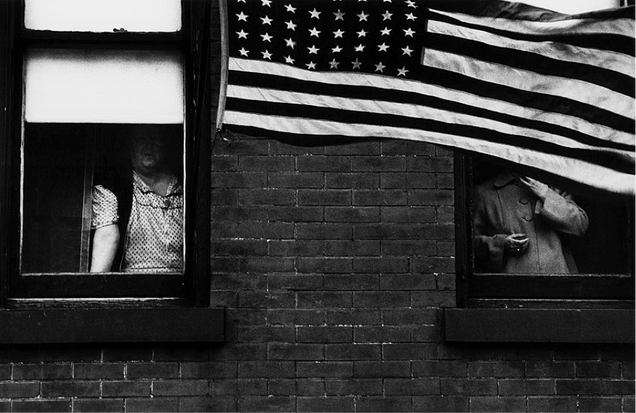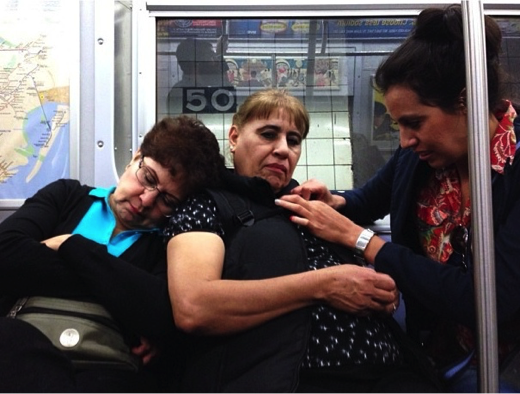Sarah White
Read the instructor’s introduction
Read the writer’s comments and bio
Download this essay
 Frank.
Frank.
With today’s popularity of smartphones and social network platforms such as Instagram, Facebook, and Tumblr, street photography is not hard to find. Taking to the streets with often just an iPhone, Daniel Arnold spends full days wandering New York City, snapping hundreds of shots of his surroundings and posting his favorites to his popular Instagram account and Tumblr blog, When to Say Nothing. Brandon Stanton, the man behind the immensely popular Humans of New York portraits, posts on several social media sites his photographs of the city’s most interesting, thought-provoking, and unique residents. Mike Kepka captures San Francisco city life in the hundreds of grayscale shots on his Instagram account, The City Exposed.
While the modern convenience of camera phones and image sharing sites makes street photography an easy endeavor, it is not, by any means, a new concept. As a genre, it is essentially as old as photography itself; many of the earliest photos were taken in the streets during the urbanization of the nineteenth century. John Thomson may have been the first to publish photographs in the genre as we know it today, focusing on London’s poor who lived and worked on the city’s streets in his 1881 Street Incidents.
When Robert Frank, a Swiss-born photojournalist, published The Americans in 1958, we were given eighty-three early street photographs depicting everyday life in the United States. Nearly fifty years later, American artist Lee Friedlander published his own epic collection of street photography taken between the late 1980s and early 2000s in America by Car. So what do these two volumes tell us about our own society and culture? And how has this visual national commentary evolved over time?
As a medium, street photography promises to provide an invaluable way of looking at a culture. It shows us how people interact with each other and with their surroundings, and we gain insight into how they structure their physical environments. Without artificial lighting, staged backgrounds, or framing, a street photographer looks around him, spots something of interest, and with a few quick snapshots his shoot is over. The street itself is fundamental in capturing these candid photos. Sustaining all of its inner movements and transactions, the street does not discriminate against class, race, or otherwise; anyone who wishes to embark upon it may.
Frank.
So if the street photography genre has so much to say, what can Frank’s and Friedlander’s pictures tell us about American culture? If we pause to think of some typical images of America, we likely conjure up the Statue of Liberty, the Empire State Building, Mount Rushmore, cowboys, baseball stadiums, hot dogs, and lots of flapping red-white-and-blue flags.
Do Frank and Friedlander represent America through these kinds of clichéd images? To an extent, yes. Some of the photos within the two volumes are so nauseatingly, overwhelmingly American that they seem to invite mockery. Frank’s volume includes a man with a gigantic cowboy hat smoking a cigar while looking on at a Detroit rodeo; a woman selling hot dogs promising to be “BIGGER AND BETTER THAN EVER!!” at a market in Hollywood; and a huge American flag hanging between portraits of Abraham Lincoln and George Washington in a Michigan bar. Friedlander captures the cheesy replica of the Statue of Liberty welcoming visitors to Las Vegas.
But these clichéd stereotypes aren’t quite at the heart of Frank’s and Friedlander’s America. Like the cowboy’s hat, these photos over-exaggerate. At the heart of America are the unremarkable gas stations, bus stops, factories, parks, suburbs, newspaper stands, drive-in movies, taxi drivers, youths, and dog-walkers that make up so much of the nation.
Frank.
The more unspectacular photos are the most realistic, the most telling of the American way of life. Frank and Friedlander offer us brief glimpses into the lives of the couples lounging in the rippling California grass (Frank), the Miami elevator girl looking longingly over her shoulder (Frank), the midnight trash collectors on Coney Island (Friedlander), the New York gentleman telling an animated story to a toast-nibbling child (Friedlander), the homeless children grinning at the camera in Manhattan (Frank), the Tennessee family lined up proudly in front of their dusty car (Friedlander).
Friedlander.
Friedlander saw the couple eating ice cream in his rear-view mirror and Frank saw the row of faces staring out from the seats of a bus, and they captured and commemorated these images so central to the American people. The photographers fail not to include the peculiarities of America: the enormous backyard replicas of the moon (Friedlander), the cowboys in the middle of New York City streets and the roadside advertisements for “Hot Babes” (Frank). Neither Frank nor Friedlander went out of their way to glamorize America.
Jack Kerouac wrote the introduction to The Americans. In it he remarks on “the humor, the sadness, the EVERYTHING-ness and American-ness of these pictures!” Kerouac marvels at the transparency of the photographs and the individuality of their subjects:
The faces don’t editorialize or criticize or say anything but ‘This is the way we are in real life and if you don’t like it I don’t know anything about it ‘cause I’m living life my way and may God bless us all…’
Frank.
Indeed there is an “American-ness” made evident through The Americans and America by Car. Frank’s and Friedlander’s street photography isn’t what John Thomson captured back in 1800s London: photo after photo of the dreary poor struggling to survive on dirty streets. That’s not to say that Americans aren’t poor, nor that their streets can’t be dirty. Frank’s volume is full of poverty and the roughness of street life, and Friedlander’s collection includes plenty of examples of dilapidated shacks and lower-class families. But even the poorest in the photos seem to bristle with a certain enthusiasm for life. The family whose greatest possession is a filthy station wagon still smiles proudly beside it. The tiny children living on the street in Manhattan beam as their photo is taken.
When Frank and Friedlander’s Americans do find wealth, they spend it on gigantic sculptures of the moon or giant cowboy hats or ice cream and hot dogs. And much of their activities involve simple things like newspaper stands and bus stops where they read about the world and travel out into it. Regardless of their social status, Americans find hope in their surroundings and joy in their lives. Perhaps this all stems from the great “American Dream” that has haunted Americans for decades, perpetuating the belief that with enough determination they can overcome their current struggles and live a better life tomorrow. Whatever the case, even through their delusions and illusions, their perseverance, hope, and pride, even in the worst of conditions, is what unites these people as Americans.
When Frank and Friedlander took the photographs that would eventually make up The Americans and America by Car, photography was a heavily involved process. Film had to be purchased, stored, developed, and scanned. Photos often couldn’t be viewed until weeks after they were taken. For Frank to have taken an extraordinary twenty-eight thousand stills before narrowing them down to the eighty-three in The Americans was an unimaginably time-consuming, expensive process. Today, however, street photographers can capture their art on their phones without compromising quality. Immediately they can view their pictures, editing, cropping, and filtering with a few swipes of a finger.
Has street photography, as a national commentary, changed much over the past several decades as we move further into the digital age? As far as the approach goes, it has become a very different form of art. When Daniel Arnold shoots, he wanders the streets snapping hundreds of pictures a day, searching for the unique, the profound, and the indescribable. He can immediately see whether they have any value, instantly deleting the ones he doesn’t care for while preserving those he finds worth in: the bodybuilder flexing in front of the ATM, the babies rolling down the street in wheeled cribs, and the lady dressed in trash bags. This allows for hundreds of photos to be taken a day without expense.
Arnold.
Additionally, street photographers can now be much more discreet with the use of the smartphone camera; this makes it easy to capture, say, the person sitting across from you on the subway without taking out a bulky camera and getting their attention.
However, as far as its purpose goes, street photography is still what it has always been. Its aim is still to capture, in an uncontrived form, the everyday movements and interactions of people within an environment. Street photography may be an easier pursuit with today’s ease of access to cameras, but the theory behind it remains the same. The subject matter may have evolved slightly from the times of Frank and even Friedlander, due to changing social structures and advancements within American society and culture. But this does not mean that street photography itself has changed.
It is indeed the purpose of street photography to capture the evolution of a people, to document the way in which a society exists at a certain point in time. Street photography itself does not evolve; rather, it holds the ability to show us how we have evolved. And even through this evolution, photos like Arnold’s of a young boy prancing down the street proudly holding aloft a huge balloon can still evoke the same relentlessly hopeful, cheerful, resilient sentiments that Frank and Friedlander did in showing just who the Americans are.




